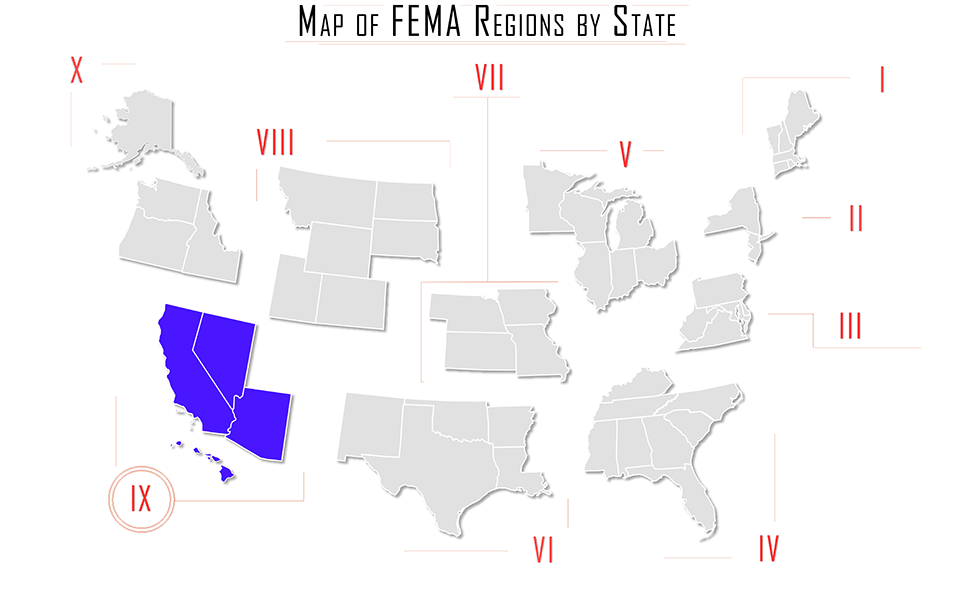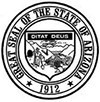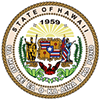.png)
At the Region is an ongoing feature that discusses the state-by-state training, certification and employment requirements of first responder departments across the nation. In this issue, At the Region looks at requirements in the western United States, including Arizona, California, Nevada, and Hawaii.

FEMA Region IX - Firefighters
Arizona
 Requirements for firefighters in Arizona are set by individual departments; however, most agencies require state certification in Firefighter I and II, as well as EMT certification (many departments require EMT certification prior to acceptance to their fire academy). Training and certification are coordinated by the Arizona Center for Fire Service Excellence (AzCFSE) within the Arizona Fire Services Institute (AFSI). AzCFSE also maintains a list of statewide training programs, and certification testing dates are provided here. Applicants have three opportunities to pass the certification exam, after which it is required that they retake a training program. Depending on department standards, minimum application age may vary from 18 to 21 at the time of hire, and agencies require that applicants possess a valid Arizona driver’s license (some areas also have standards relating to an applicant’s driving history).
Requirements for firefighters in Arizona are set by individual departments; however, most agencies require state certification in Firefighter I and II, as well as EMT certification (many departments require EMT certification prior to acceptance to their fire academy). Training and certification are coordinated by the Arizona Center for Fire Service Excellence (AzCFSE) within the Arizona Fire Services Institute (AFSI). AzCFSE also maintains a list of statewide training programs, and certification testing dates are provided here. Applicants have three opportunities to pass the certification exam, after which it is required that they retake a training program. Depending on department standards, minimum application age may vary from 18 to 21 at the time of hire, and agencies require that applicants possess a valid Arizona driver’s license (some areas also have standards relating to an applicant’s driving history).
Reciprocity
Reciprocity is determined by individual departments, and it is strongly recommended that out of state applicants contact their department of interest to establish their current policies and guidelines. Be advised that some Arizona departments do not accept lateral transfers regardless of past training or work experience. For state certification where required, the Arizona Center for Fire Service Excellence (AzCFSE) offers a testing process for Firefighter I and II using NFPA standards, including a written and practical skills test. This exam must be passed on the first attempt, or training through an Arizona Certification Program will be required. The application for reciprocity and testing may be downloaded here. To meet the basic requirements in many departments, it is recommended that applicants be NREMT certified prior to seeking employment opportunities, as this is required in Arizona when seeking out of state reciprocity for EMTs.
California
 The California Department of Forestry and Fire Protection recognizes three primary levels of Firefighter certification: volunteer, Firefighter I, and Firefighter II. To receive Firefighter I certification, applicants must complete the approved training, verified under the Firefighter I training record, and possess experience, as demonstrated by serving for six months as a paid firefighter in a California department, or one year part-time paid, or volunteer experience. Firefighter II requires completion of the requisite training and record, as well as one year paid, or two years volunteer/part time experience with a California department. A full breakdown of the requirements can be found in the State Fire Training Procedures Manual, located here, and additional training resources, dates, and courses may be found on the state website here.
The California Department of Forestry and Fire Protection recognizes three primary levels of Firefighter certification: volunteer, Firefighter I, and Firefighter II. To receive Firefighter I certification, applicants must complete the approved training, verified under the Firefighter I training record, and possess experience, as demonstrated by serving for six months as a paid firefighter in a California department, or one year part-time paid, or volunteer experience. Firefighter II requires completion of the requisite training and record, as well as one year paid, or two years volunteer/part time experience with a California department. A full breakdown of the requirements can be found in the State Fire Training Procedures Manual, located here, and additional training resources, dates, and courses may be found on the state website here.
Once the requirements for training and experience have been met, contact your local Department for the firefighter Red Scantron application; once this document has been completed, it will need to be signed by the Fire Chief or authorized signatory. Applications for firefighter I and II certification are $40 each; a full list of the application costs may be found here. Completed applications and fee schedules should be mailed with payment to: State Fire Training, ATTN: Cashier, PO Box 997446, Sacramento, CA 95899, or delivered in person to the State Fire Training office, 1131 "S" Street Sacramento, CA 95811. Applicants seeking same-day certificates should schedule an appointment for processing by calling the office at (916) 445-8200.
Reciprocity
State Fire Training in California does not recognize out of state certifications including IFSAC and ProBoard, and requires that firefighters serve with a California department prior to eligibility for certification. Training received in another state may be recorded on the Firefighter I training record if considered equivalent by a California department at their discretion; this is applied at the local rather than state level.
Nevada
 Oversight and accreditation of training in Nevada is provided by the State Fire Marshal Division of the Nevada Department of Public Health. The standards issued by the Nevada Board of Fire Services under this department generally follow NFPA certification standards, and specific training requirements, such as course hours, are left to the discretion of local jurisdictions. Minimum state standards require that firefighters complete all required training, attending a minimum of 90% of the outlined course time, meet physical fitness, cognitive, and psychomotor requirements, be at least 18 years old, and have the approval of the agency Chief or administrator before applying for certification. Applicants must also pass a written and practical examination, as defined by the standards provided here.
Oversight and accreditation of training in Nevada is provided by the State Fire Marshal Division of the Nevada Department of Public Health. The standards issued by the Nevada Board of Fire Services under this department generally follow NFPA certification standards, and specific training requirements, such as course hours, are left to the discretion of local jurisdictions. Minimum state standards require that firefighters complete all required training, attending a minimum of 90% of the outlined course time, meet physical fitness, cognitive, and psychomotor requirements, be at least 18 years old, and have the approval of the agency Chief or administrator before applying for certification. Applicants must also pass a written and practical examination, as defined by the standards provided here.
Reciprocity
Reciprocity may be granted following a review of the applicant’s current certification and experience records by a State Certification committee including the Certification Coordinator, Chairperson, and a member of Nevada’s fire service with a current equivalent certification. Nevada may also offer credit for training hours received in other states, though normal testing requirements would still apply.
Hawaii
 Local agencies in Hawaii set the standards for firefighters, with all departments requiring a minimum age of at least eighteen, the ability to pass physical standards tests, and generally a written exam, and/or interview. Training is offered either through individual departments, or a combination of department and community college programs that provide classroom instruction. Contact the department of interest for requirements, or check regional government job sites for openings (for example, the Honolulu Fire Department lists open positions on the County website). Firefighters also have the opportunity to join collaborative agencies such as the Hawaii Firefighters Association.
Local agencies in Hawaii set the standards for firefighters, with all departments requiring a minimum age of at least eighteen, the ability to pass physical standards tests, and generally a written exam, and/or interview. Training is offered either through individual departments, or a combination of department and community college programs that provide classroom instruction. Contact the department of interest for requirements, or check regional government job sites for openings (for example, the Honolulu Fire Department lists open positions on the County website). Firefighters also have the opportunity to join collaborative agencies such as the Hawaii Firefighters Association.
Reciprocity
Lateral transfer agreements in Hawaii, if available, are determined on a department-by-department basis and may vary. If you are interested in transferring to a department in Hawaii, it is recommended that you contact the agency regarding their reciprocity standards; be aware that some large agencies in the state do not accept lateral transfers of any kind, and that pay structures may not account for experience obtained in out of state departments.








